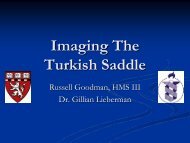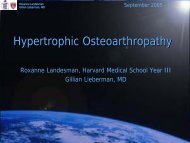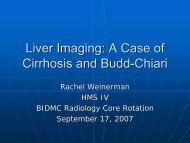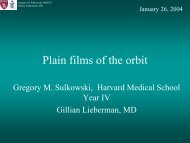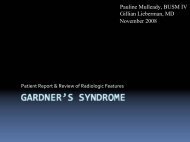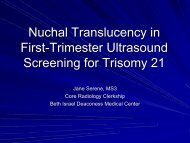The Basics of MRI: T1 vs. T2
The Basics of MRI: T1 vs. T2
The Basics of MRI: T1 vs. T2
Create successful ePaper yourself
Turn your PDF publications into a flip-book with our unique Google optimized e-Paper software.
Frank Minja, HMS III<br />
Gillian Lieberman, MD<br />
<strong>T2</strong> Weighting<br />
• <strong>T2</strong> is the rate <strong>of</strong> decay <strong>of</strong> precession as a result <strong>of</strong> magnetic moments<br />
falling out <strong>of</strong> phase.<br />
• This rate <strong>of</strong> decay again depends on the local environment, thus the <strong>T2</strong><br />
signal depends also on the local environment (different tissues have<br />
different <strong>T2</strong> constants)<br />
• A special pulse <strong>of</strong> RF is used to measure the <strong>T2</strong> signal. This pulse<br />
reverses the precessing magnetic moments by 180 degrees.<br />
• Reversing the plane <strong>of</strong> precession<br />
• <strong>The</strong> reversal results in an ‘echo’ signal<br />
• 180 degree RF pulse followed by an ‘echo’ <strong>T2</strong> signal<br />
• <strong>The</strong> maximal echo signal is the <strong>T2</strong> signal<br />
• <strong>The</strong> time between echoes = TE<br />
• <strong>The</strong> longer the time between echoes = the better the <strong>T2</strong> contrast<br />
• Thus, <strong>T2</strong> weighting = Long TE (Echo Time)<br />
12



